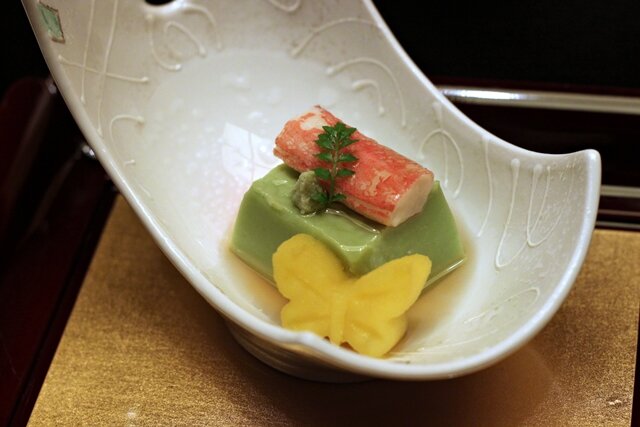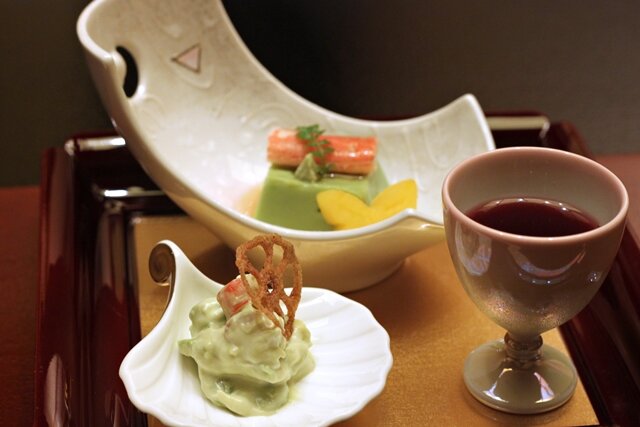Sojuan Serves a Classy Kaiseki Meal in Tokyo
When people ask about my recent trip to Japan, I’ve been joking that during my short, eight-day stay, I enjoyed four bowls of ramen and survived one earthquake.
Those four bowls of ramen are just scratching the surface of my feeding frenzy in Tokyo. In addition to some delicious home-cooking with friends and family, I enjoyed delicious Japanese pastries, a couple of izakaya meals, katsu-karē (deep-fried breaded pork cutlet with curry sauce), katsuo donburi teishoku (skipjack tuna over rice set menu), yaki zakana teishoku (grilled fish set menu) kaiten-zushi (conveyor belt sushi), traditional sushi, and more.
My favorite meal of this trip, though, was at Sojuan—a kaiseki-style restaurant in the Keio Plaza Hotel. (Note that there’s a wide variety of restaurants inside the hotel—from French to Chinese to Italian to Korean—inside the hotel, as well a few very comfortable, scenic, and historical bars and lounges.) Kaiseki is a traditional, multi-course meal that is stunning in presentation and carefully composed in terms of looks, flavors, colors, textures, and seasonality. Dishes, bowls, and other vessels are beautiful and purposeful, with leaves and flowers connecting food to nature, and edible garnishes typically depicting fauna and flora.
The Keio Plaza Hotel is a monstrous, classical hotel (a bit institutional) with 1,435 guest rooms in the busy Shinjuku district of Tokyo. But make your way to Sojuan on the second floor, and you’ll feel like you’ve entered another world—natural and peaceful. And if you’re lucky enough, like me, to take your meal in one of the koshitsu (private dining rooms), you’ll feel further tranquility. (This is the quiet atmosphere I complain that Capitol Hill’s Momiji is lacking to allow full appreciation of kaiseki quality food.)
The nakai-san, a kimono-clad server, will be yours—attentive to your needs, including the timing of your dishes. Gently knocking before sliding open the shoji door, she’ll gracefully remove dishes, present new plates (sometimes portioning out food), pour tea, and anything else you need. In a society without tips, service is par excellence.
I had a chance after the meal to speak briefly (via translation) with chef Hiroichi Yazaki:
How long does it take to become a kaiseki chef?
I started working at the low level as an apprentice at a ryotei restaurant in Asakusa when I was 18. I worked there for two years and did everything helping the chef—like shopping, cleaning, and making a bath for him. Then I moved to a kappo restaurant in Kanda and worked there for two years, doing all the yaki (grilled) dishes. Eventually I moved a high-end Japanese restaurant in Shinbashi where I had to do everything by myself: ordering, preparing, cooking…everything. In general, it takes 20-30 years to become a top level chef in traditional Japanese cuisine, but it depends on the person. Maybe young people right now have a different experience. It used to be more strict, but it’s changing.
How often do you change the menu, and how long does it take to create it?
The menu changes every month. Mostly it takes about two weeks to create, but I’m thinking about it every day. I’m always thinking about work. Even when I’m commuting, I’m thinking.
What is your favorite season for food?
Autumn to winter, because we get many different kinds of ingredients during that period. It’s also an easy time for decorating and plating because, for example, the momiji (Japanese maple leaves) are available. Presentation at this time is fun.
When did you know you wanted to become a chef?
I’m from Kagoshima. My uncle was a chef, so I started to think of this kind of work as a high school student. I helped my uncle at his traditional Japanese restaurant.
What is your favorite food to eat when you go out?
Kyoto-ryori (the food of Kyoto), ippin-ryori (Japanese small plates), and also kaiseki to learn new things. But mostly washoku (traditional-style Japanese food).
(Pointing to his uniform) Do you wear a tie when cooking in the kitchen?
I have a tie because in the kitchen there are 40-50 people working, so wearing a tie is a symbol of the head chef.
***
I commented that it must be too hot in the kitchen for a tie, and he indicated that he’d never complain. That’s the Japanese way. Aiming to please.
At this point, the nakai-san told the chef that we had polished off all of our plates. Both were surprised, and he was quite pleased.
(See the slideshow above for dishes from the meal, and more.)


 Daily Email Digest of The SunBreak
Daily Email Digest of The SunBreak